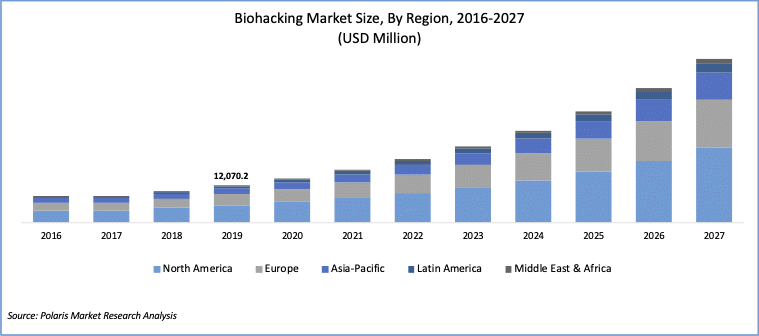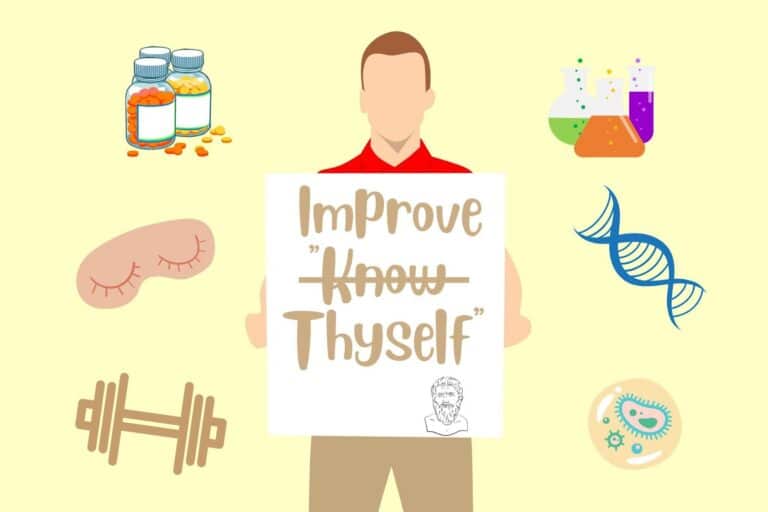Do you recall how much time has passed since we did not know what to do with personal computers? Or since “tube babies” were considered to have health problems? Do you bet we will all finally jump off the “biohacking” cliff?
Humanity is constantly evolving. We are always eager to improve who we are to a different extent. As science and bio-medicine continue to push the limits, we are moving from a natural selection to an “engineer-determined” future. People have consistently failed to say no to technology, so, predictably, many people, from professional biologists and scientists to curious amateurs, are trying to take control of their biology.
The Definition Overlook
In a nutshell, biohackers are people who promote the Do-It-Yourself mindset to medical treatment and try to “hack” their bodies and minds in different areas like longevity, disease treatment and prevention, athletic ability, memory, cognitive function, and many others. They often neglect the usual route and safety checks of clinical research to get fast results and share them with a broad audience. Though many in the medical community are outraged by the risks of unprofessional behavior as serious science requires time and effort, Acumen Research and Consulting reports the biohacking market share will surpass US$ 66.7 Billion by 2028.

The movement includes well-known traditional strategies, like meditation, physical activity, stoicism, personal nutrition, intermittent fasting, herbal therapy, sleep experiments, etc. Many of these age-old traditions have proven their effectiveness and safety over thousands of years.
Other novel concepts need some cutting-edge technologies for implementation. They encourage genetic profiling and gene modification, wearable medical devices, neurofeedback, near-infrared saunas, smart drugs or nootropic, altitude simulation, devices under your skin, and others. Entrepreneurs resourcing that kind of technology are pushing these things as cures, but many of them are in their infancy. We do not know for sure if they will perform at all or if the potential “good” will outweigh the risks.
Let’s dig deeper into some famous, some weird, and some mind-blowing biohacking illustrations to understand what kind of “hodgepodge” the community appears to be.
Ketogenic Diet
Ketosis is one of the leading nutritional technics that got recognition in biohacking. The main idea is that the majority of people can process fats faster than other energy sources like glucose. Clinical studies demonstrate that following a keto diet for 24 weeks lessens the body mass index, glucose level, and LDL cholesterol in the blood. Above that, it can positively affect cognitive functions upgrade and multiple sclerosis treatment.
The state of ketosis can be acquired by choosing 70-80% of fats in your daily nutrition plan, with 10-15% given to proteins and 5-10% to carbohydrates. Thus, we switch to getting energy from the body’s fat content instead of glucose.

Additional supplements like sodium, potassium, calcium, or magnesium are known as ketone salts. They are external synthetic sources for producing ketone bodies. Some supporters also experimented with enriching the diet with cannabinoids, used to treat various medical conditions from ancient times. Chef Brandon Alen says that boosting the endocannabinoid system with phytocannabinoids benefits nutritional ketosis.
Despite all the above-mentioned positive impacts choosing a ketogenic diet may provoke some side effects called the “keto-flu” headaches, muscle pain, diarrhea, and others. So consulting the therapist is a must-have before starting your keto-way.
Young Blood Transfusion
It may seem like Dracula-style manners, but this procedure has become popular in Silicon Valley, with its cost reaching $8000 per liter, supplied by Ambrosia Company. The promise is that a young person’s blood transfused into an older person’s veins leads to rejuvenation.
It all started in the 2000s when a group of Stanford scientists resurrected a parabiosis procedure from the 1950s. In short, they connected the blood circulatory system of the two mice and found evidence of renewal in the muscles and livers of the old mice. In 2005 their results drew the attention of the public worldwide, and many startups experimenting with “refreshing” plasma to forestall aging emerged.
Though the mainstream has found its place on the menu at a society gala, FDA released a warning that young blood transfusions have no proven clinical benefit to delay aging or treat other diseases. Still, it left the door open to further exploration. Elevian company continues research on therapies to elevate the protein in the blood, reducing with age in mice. At the same time, Alkahest works on creating a proprietary fraction for patients with moderate Alzheimer’s disease. So these or similar experimentations might be the next big thing to bring the Dorian Grey effect to reality.
Genomics
In brief, genomics is the study of a person’s genetic information. Thanks to the developing technologies, single genome sequencing cost $1,000 instead of $95 million in 2001. It’s no surprise that biohacking initiatives, from genetic profiling and DIY body improvements to gene editing in embryology, have become a fast-growing tendency.

One of the hot trends is nutrigenomics which guides us on how particular food interacts with our genes. This data promises to provide tailored nutritional strategies to prevent polygenetic diseases like obesity, type 2 diabetes, and others. Although scientists sparsely prompt using it for genomic purposes, many new startups arose in this medical domain to satisfy the hunger of the early adopters. Tray Wellness is an example of a service that can answer questions like whether caffeine and fats are good for you, what type of workout fits you best, whether fasting is appropriate in your case, and many others.
At the same time, genomic profiling has proved effective in discovering the risk of developing many inherited illnesses. Among such diseases are cancer, rare lung diseases, celiac disease, and many others. Understanding of disease’s genetic aspects and drug response is constantly growing, and new genetic tests are continuously introduced and can be used shortly for preventive medicine and effective therapy.
CRISPR is another revolutionary genetic technology worth mentioning. It works as molecular scissors that can cut strands of DNA and replace them with a correct sequence. It has enormous promise as a precious medicine for the treatment of such diseases as inherited blindness, deafness, cancer, diabetes, and others. In the DIY biohacking community Josiah Zayner, whose company Odin sells genetic kits and classes, made lots of noise after injecting himself with the gene-editing tool CRISPR to enhance his muscles. Nevertheless, he expressed his regret for that later. “There’s no doubt in my mind that somebody is going to end up hurt eventually,” he said. The recent 2022 report indicates that clinical trials are being conducted yearly in the USA, but they are still early. That means it will probably take years before the CRISPR tool gets approved and widely operated.
Eventually, emerging technics are already practiced in embryology to correct genetic problems. An assisting reproductive technology pronuclear transfer aims to prevent inherited mitochondrial disorders by moving one pronuclei zygote to another. As a result, the future embryo has nuclear DNA from his parents plus a donor’s mitochondrial DNA. Though FDA banned further clinical trials connected with mitochondrial replacement techniques in the USA, researchers in other countries continue to labor with this strategy.
The Safety Lines
Spirituality is not directly connected to science but is still the foundation of ethics. It brings to light the “should we really do it” question. Improving our physical powers to the level everyone else has seems like a decent story. Thus, we may all be equal in how we experience our life. But while discussing superficial enhancement, we may get on a slippery slope. Unless everyone can access the godsends independently of their social condition, we may end up with eugenics splitting humanity into superior and inferior.
So this also raises the question of governance and who will profit from the technology. Insulin found back in 1923 was sold by its inventors for a mere $1 as they felt uncomfortable profiting on a discovery that could save so many lives. But still, the price of one vial of Humalog (insulin lispro) increased by more than 1000% from 1999 to 2019, which dramatically exceeds the cost of its production. As there is no blueprint for how we control advancing biotechnology across the planet, its fast move may throw up more yet.
Moreover, there are predictable risks in pursuing some biohacking attempts outside the scientific realm. Luckily, some academic organizations, like Genspace, provide the possibility to educate amateurs about gene editing and upcoming technologies. For membership fees, it offers introductory courses, and you can have your desk within a laboratory and get help with experiments. Doing so decreases the number of people who design something in their hidden labs without considering the consequences.
After all, what happens if we finally stop all the diseases and rewrite the book of life? What will be the outcome when all of a sudden, our finding allows us to do what we have not previously suspected? We should not evaluate innovations by the best potential use; we must keep abreast of what can be done behind the scenes. No one knows how it might play out and what kind of humans we will be.



